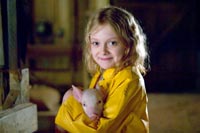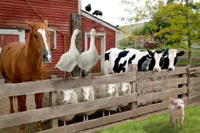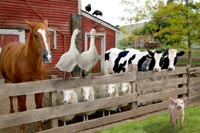E. B. White’s Charlotte’s Web, the best-selling children’s paperback of all time, has remained one of the greatest masterpieces in kid lit for more than fifty years—as a bedtime story with their parents, or perhaps as the book that awakened their own love of reading. And for some, it’s a tale unwittingly etched into the brain, thanks to a little sister who wouldn’t stop playing the 1973 animated adaptation over and over against her brother’s will … but I digress.
Book adaptations are a two-edged sword, capable of causing great anticipation, but also great worry. What seems like a safe bet for a blockbuster hit can quickly turn into an infamous flop if the movie strays too far from the source material, or a dry retread if it sticks too closely to it—and the stakes are even higher when it’s a beloved classic like this.

Fortunately, this version gets it right. Yes, there are some questionable additions. And at times it plays the book’s story too straight. But to quote another classic involving an adorable little swine, “That’ll do, pig.”
As with Babe, this is the story of a pig hoping to escape his inevitable fate as Christmas ham. Wilbur (voiced by 10-year-old Dominic Scott Kay), the runt of the litter, is spared from Farmer Arable’s ax at the pleading of his young daughter Fern (Dakota Fanning), who raises the piglet like a puppy until he becomes too big for her to keep. There’s room for him at the nearby farm of Uncle Homer Zuckerman (Gary Basarba), but that’s no guarantee that Wilbur won’t become bacon by year’s end.
Enter Charlotte (voiced by Julia Roberts), a graceful and articulate spider who befriends Wilbur. When the young pig’s future seems questionable, Charlotte commits her life to saving him the only way she knows how—with her weaving skills and Marketing 101. By webbing words like “Some Pig” and “Radiant” over Wilbur’s pen, she pulls a publicity stunt on Zuckerman and his neighbors (“It’s a miracle!”), perhaps proving Wilbur’s worth by attracting visitors and, ultimately, winning a ribbon at the State Fair. Anyone familiar with this G-rated story knows there’s a happy ending, but not without some twists and tears along the way.

Director Gary Winick (13 Going on 30), with a screenplay by Karey Kirkpatrick (Over the Hedge) and Susannah Grant (In Her Shoes), remains true to the story and spirit, apparent even from the narration and sketch drawings used over the opening credits.
But it’s not flawless. There are some inconsistencies to the CGI effects. As an animated creation for most of the film, Charlotte is rendered with realism, and there’s a terrific scene that plays up the beauty of her work, weaving her first message with the agility of Spider-Man. Templeton, the barnyard’s tenacious and gluttonous anti-hero of a rat, is equally entertaining with the necessary comedic relief. But why do those geese look so terrible—like those little toy animal heads on sticks that open and close their mouths when the lever is pulled?
The all-star voice talent is varied, and with mixed results. Oprah Winfrey and Cedric the Entertainer are the worst as goose and gander Gussy and Golly, ditching some of the book’s heart and humor in favor of clichés and stereotypes. Kathy Bates and Reba McEntire aren’t much better as a pair of gossiping, gassy cows. But John Cleese is fun, if not predictable, as lead sheep Samuel, and Robert Redford is enjoyable as Ike, a horse with arachnophobia.

But they’re all overshadowed by the strength of the key characters. Steve Buscemi was born to play lovable rats—figuratively and now literally. As Wilbur, Key voices the pig with believable love and wonder. And though Roberts seems a little too tired and annoyed in her first scene, you warm up to her tender portrayal quickly after—despite the eight hairy legs.
Give credit to the live actors too, particularly Fanning, who’s finally outgrown all those roles as the overly precocious child in a fantastic situation. She’s far more engaging as the average girl, making Fern’s love for Wilbur all the more genuine and believable.
Now, about those additions … The book doesn’t have the action to sustain a film like Babe did, so they’ve created some—primarily involving Templeton, journeying into his rat-hole, or else going on junkyard missions to retrieve words for Charlotte’s work. This introduces two new characters—a pair of crows voiced by Thomas Haden Church (Sideways) and André Benjamin (Outkast) intent on catching themselves a rodent. It generally works, even if it does feel a little tacked on.
But why some of the other changes? Beau Bridges appears as Doctor Dorian, who in the book was used to drive home some of the themes about maturity and miracles, but here his speeches are somewhat abbreviated, so that his wonderful insights lose some of their punch. Some details have been changed too. In the book, the Zuckermans lived “down the road” from the Arables, making Fern’s visits special—another act of love on her part. In the movie, they literally live across the street, so why wouldn’t Fern visit the farm every day? Why would it be considered odd to spend time in the equivalent of her backyard?

The film tries really hard at humor, and succeeds with some clever transitions—like cutting from Wilbur to bacon frying in a pan. But overall, the laughs are more of the Saturday morning cartoon variety than the clever all-ages humor one might hope for. The cows pass gas, they suck up their drool, Templeton burps—eh, but kids love it and this is a barn, right? I was more frustrated with forced jokes, like Zuckerman’s farmhand Lurvy, who seems to read fine in one scene, but misreads Charlotte’s writing as “So Me Pig” in another. Or Templeton breaking a rotten egg and then running out of the bard chiding, “Last one out is a rotten egg … well, I thought it was funny.” Lame.
Ah, but the film’s saving grace is that it takes subtle themes from the book and runs with them fully, pumping up the dialogue with some excellent life lessons that work well with Christian beliefs, making this an ideal movie parable for kids. The most obvious example is Zuckerman’s heartfelt speech toward the end about finding miracles in the ordinary and the everyday. Also, consider Charlotte’s final word used to describe Wilbur, and how it inspires Zuckerman and his fellow townsfolk. And there’s Wilbur showing compassion to “the least of these” by forging a friendship with a reviled spider. Charlotte in turn selflessly dedicates her life to save that of another, so that he might live to see Christmas. “Should I worry?” asks Wilbur. “Of course not,” the spider calmly responds, “what good would that do?” The Arables are shown going to church, Charlotte offers grace before a meal. Am I stretching? Even the wording for the movie poster’s tagline is interesting: “Help is coming from above.”
This movie never quite does full justice to White’s book, and it may simply be a story that’s stronger on the written page. But little gripes aside, it’s terrific—or radiant, pick your own word from the web—and bound to satisfy the intended audience … perhaps communicating something even deeper than expected to a new generations.
Talk About It
Discussion starters- What is the nature of miracles? Are they always “big” things? Can they appear in the small, ordinary and trivial? How does God work them into our lives? Any personal examples
- Some would suggest that Wilbur does nothing in this story, that he sits back while Charlotte works to save him. Do you agree? How does he demonstrate the qualities used to describe him? How do these qualities make him more appreciated in a practical way? How do they compare to Christian qualities
- Think about the sacrifices Charlotte makes to save Wilbur. Does laying down one’s life necessarily mean death? What does it really mean to show no greater love and live a life of self-sacrifice
- What four (technically five) words are used to describe Wilbur in Charlotte’s web? Which quality seems to be most important in saving his life and why? How is this quality demonstrated in the way he interacts with others? How does it mirror the way we’re called to treat others as followers of Christ
- Does Charlotte impact the lives of others besides Wilbur? How do we know that she’s earned their honor and respect? Why do you think their lives are changed, since she didn’t save their lives directly
- The story has much to say about how one life can affect others for good. Consider how a single act can do so much good by using examples from the film. Charlotte is the most obvious example. Does Wilbur make a lasting impact on others for good? What about Templeton? Fern? Fern’s father? Others?
The Family Corner
For parents to considerCharlotte’s Web is rated G and suitable for family audiences. A British-voiced sheep uses the phrase, “Bloody herd.” There’s also some sophomoric humor involving belching, drooling, and flatulence, but those help provide some levity to an otherwise serious story. Like the book, there are death-related themes, but if kids are old enough to appreciate the book, they’ll be fine with the movie.
Photos © Copyright Paramount Pictures
Copyright © 2006 Christianity Today. Click for reprint information.
What Other Critics Are Saying
compiled by Jeffrey Overstreet from Film Forum, 12/21/06Charlotte’s Web, by E.B. White, now, that’s some book. And its generations of fans have long been grateful that the only movie version of the book—a musical animated feature from 1973—is actually quite memorable and worthwhile.
So it is with fear and trepidation that the story’s countless fans are approaching the flashy new Hollywood version of White’s classic tale directed by Gary Winick. After all, too many forgettable talking-animal tales have traipsed across the screen in the last few years.
And it wasn’t necessarily good news when it was announced that the new version would be loaded with celebrity voice talents. That’s sure to sell tickets, but it can wreak havoc on the art of storytelling if the actors’ familiar personalities overpower the personalities from the pages of the book.
But according to Christian film critics, this Web—with a screenplay adapted by Susannah Grant and Karey Kirkpatrick—is impressively spun. It isn’t perfect, but most reviewers are recommending it to families for Christmastime viewing.
“I’d rather rewatch the cartoon with my kids,” Steven D. Greydanus (Decent Films), “or better yet, reread the book.” But he does rate it as “fair family entertainment, though the story would have been better served by a more faithful adaptation—and more inspired direction. The basic appeal of White’s story is sturdy enough to survive the filmmakers’ more dubious choices, and the emotional climax may even leave viewers with a lump in their throat.”
Bob Hoose (Plugged In) says, “This new non-musical version has a few flat spots. … But there’s something very endearing about E. B. White’s tale of friendship and innocent longing to believe the best of others. The CGI special effects are realistic … the Norman Rockwell-esque setting is welcoming, and the script is funny and engaging. It’s Wilbur expressing wonder over the ‘ordinary miracles’ of everyday life, though, that will most charm the kids and inspire the rest of us.”
David DiCerto (Catholic News Service) says it’s “one of the best family films of the year. … While the 1973 animated version is hard to beat, Winick’s use of live action—enhanced by computer effects as in Babe—is charming, and the all-star voice talent … is obviously impressive.”
Also a fan of the book, Christa Banister (Crosswalk) says it’s a “lovingly crafted film that mostly stays faithful to the book, given an artistic liberty here and there for the sake of humor. And fortunately, unlike a lot of kids’ movies these days, the jokes take the witty course, rather than relying on pop culture references, sexual innuendo or an abundance of flatulence.”
Kathy Bledsoe (Past the Popcorn) says, “The important messages of Charlotte’s Web are intact and strong in this new movie version. … [T]he movie brings [the author’s] imagination to full living color and life that parents and children can enjoy together. … Give a really great family gift this holiday season and see a film that is both enjoyable and educational.”
Most mainstream critics are finding ways to use the word “terrific,” of course.












